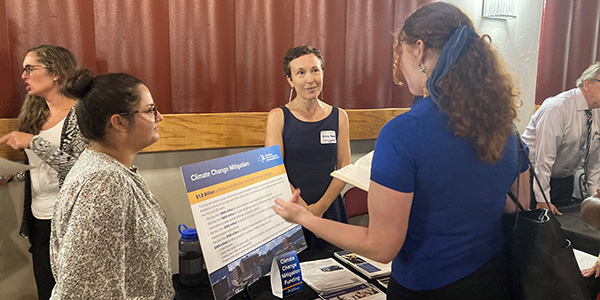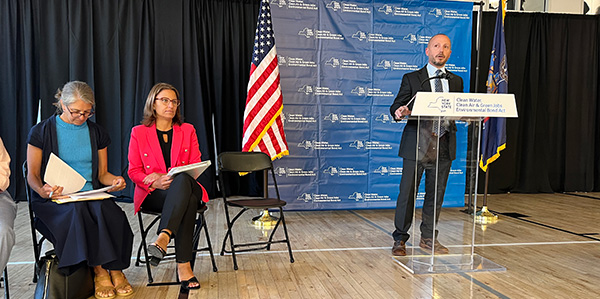
Looking up at the screen from a folding chair in the middle of the Westchester County Center’s Little Theater, surrounded by a couple hundred representatives from environmental agencies, elected officials and their staffs, state agency teams, and more than a few concerned citizens, everything seemed so simple.
The slide on Water Quality Improvement and Resilient Infrastructure cleanly and helpfully broke down how $650 million will be allocated:
- $250 million to support municipal stormwater grants
- $200 million for water infrastructure improvement projects
- $200 million for other programs, ranging from “replacing aging and substandard septic systems” to “lead service line replacement”
Seemed clear enough.
There were other such slides, identifying, say, the different spigots through which the $1.1 billion of funds earmarked for Restoration and Flood Risk Reduction will flow. Through the entire mid-August presentation, the message delivered by an all-star lineup of state agency speakers was consistent: since last November, when two out of three New York voters supported Proposition 1 and passed the $4.2 billion Clean Water, Clean Air, and Green Jobs Environmental Bond Act, there has never been a better time for communities across the state to invest in projects to address the compounding problems of aging infrastructure and escalating climate-related challenges.
But there’s a not-insignificant difference between having funds available and getting them into the hands of the people who can put them to best use. If distribution were as straightforward as the slides implied, Governor Kathy Hochul wouldn’t have had to dispatch the leaders of the Department of Environmental Conservation, the New York State Energy, Research, and Development Authority, the Office of Parks, Recreation, and Historic Preservation, and others to all corners of the state, from Buffalo to Brentwood.
Officially, this was billed as an eight-stop summer “Listening Tour.” Practically, it was more of a rollout roadshow, an in-person introduction to the mechanisms being installed to ensure maximum possible efficiency in a massive bureaucratic initiative.

To that end, the most helpful part of the sessions attended by Save the Sound staff in Westchester County, the Bronx, and on Long Island was the breakout conversations that followed the formal presentation. Agency staffers set up behind a series of tables, each dedicated to a specific funding category prioritized by the Bond Act. These impromptu conversations were where the listening part of the listening tour actually happened, even if the answers to questions asked are still works in progress.
During last week’s event at La Central YMCA in the Bronx, the breakouts were where Alex Rodriguez, our environmental justice specialist, got to learn a little more about the ways the Bond Act will complement the state’s Climate Leadership and Community Protection Act (CLCPA). Similar to Connecticut’s Global Warming Solutions Act, New York State’s CLCPA is among the most ambitious climate laws in the nation and requires New York to reduce economy-wide greenhouse gas emissions 40 percent by 2030 and no less than 85 percent by 2050 from 1990 levels.
“Regarding advancing environmental justice, the following goals are most favorable in elevating communities that have been disproportionately impacted by environmental injustices. The Bond Act will allocate $500 million for zero-emission electric transit and school buses; $400 million for green building retrofits; $300 million for urban forestry and carbon sequestration; $200 million for reducing air and water pollution; and $100 million for climate adaptation and mitigation projects,” said Alex, noting that the state aims to direct 35% of Bond Act investments to state-identified Disadvantaged Communities.
In White Plains, the tables also were where Nicholas Demitraszek, program coordinator for the NYS Environmental Facilities Corporation, emphasized the importance of municipalities researching the different objectives and eligibility criteria for all the various available grants.
“We hear from a lot of people who have a project idea that they’re excited about it, but they haven’t thought about where the money will come from,” said Nicholas, who acknowledged that even he has to check with engineers sometimes before directing an inquiry to the appropriate funding source. “It’s important to understand the narratives of each program.”
And there are a ton of programs, as you’d expect when you’re trying to dispense $4.2 billion. Fourteen pages’ worth of state and federal funding sources, in fact. It’s why EFC has created Community Assistance Teams to help make sense of clean water infrastructure funding opportunities. This way, a municipality looking to fund pressure testing on a fire department’s piping system wouldn’t mistakenly apply for a drinking water grant, which has happened. And it’s why EFC is considering creating a municipal mentorship program, where people from one community who have navigated the complicated grant application terrain could advise people from neighboring communities.
Implementing the Environmental Bond Act was never going to be easy. Not initially, anyway. But the framework is materializing, and soon the funding will make its way into communities across the state.
“It’s encouraging,” said David Ansel, our vice president of water protection, who attended the listening tour’s last stop last Thursday at Suffolk County Community College. “What I heard was the state of New York telling municipalities, NGOs, real estate developers, and everybody else to get focused on doing the types of projects that focus on clean water infrastructure and resiliency and climate mitigation. Those were the top issues they discussed, and they all happen to be among our top priorities.”
